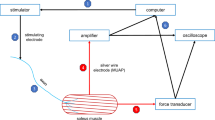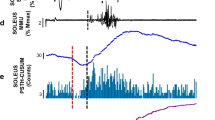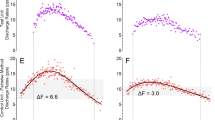Abstract
The aim of the study was to investigate sex-related differences in contractile properties, parameters of action potentials, and mechanisms of force regulation of motor units in the rat soleus muscle, which is a frequent experimental model in animal research. It was revealed that the mean mass of the muscle in males was bigger than in females, by approximately 80 %. However, the relation of the muscle mass to the body mass was not significantly different. These results correspond to approximately twice as much tetanic force per motor unit in male rats, and higher maximal contractile output, reflected by the force–time area per stimulus pulse. On the other hand, no differences were observed with respect to twitch forces of motor units. Thus the twitch-to-tetanus ratio was significantly higher in females. Additionally, the contraction and the half-relaxation times were significantly longer in female motor units, which might be due to differences in muscle architecture. The force–frequency curve in males was shifted rightwards with respect to females, indicating that the same relative level of tetanic force could be achieved at considerably lower stimulation frequency in females. The analysis of motor unit action potentials revealed about four times higher amplitudes in male rats, whereas the time parameters of action potentials were similar. The motor units in male and female rat soleus are considerably different and these observations should be taken in the consideration in various experiments on the muscle.





Similar content being viewed by others
References
Betto DD, Zerbato E, Betto R (1986) Type 1, 2A and 2B myosin heavy chain electrophoretic analysis of rat muscle fibers. Biochem Biophys Res Commun 138(2):981–987
Burke RE, Levine DN, Tsairis P, Zajac FE (1973) Physiological types and histochemical profiles in motor units of the cat gastrocnemius. J Physiol 234:723–748
Burke RE, Levine DN, Salcman M, Tsairis P (1974) Motor units in cat soleus muscle: physiological, histochemical and morphological characteristic. J Physiol 238:503–514
Celichowski J, Bichler E (2000) The influence of increasing and decreasing frequency of stimulation on the contraction of motor units in rat gastrocnemius muscle. J Physiol Pharmacol 51(4):847–855
Celichowski J, Drzymała H (2006) Differences between properties of male and female motor units in the rat medial gastrocnemius muscle. J Physiol Pharmacol 57:83–91
Celichowski J, Drzymała-Celichowska H (2007) The number of motor units in the medial gastrocnemius muscle of male and female rats. J Physiol Pharmacol 58:821–828
Celichowski J, Grottel K, Bichler E (2000) Relationship between the tension-time area and the frequency of stimulation in motor units of the rat medial gastrocnemius muscle. J Physiol Pharmacol 51(2):291–302
Chamberlain S, Lewis D (1989) Contractile characteristics and innervation ratio of rat soleus motor units. J Physiol 412:1–21
Chow RS, Medri MK, Martin DC, Leekam RN, Agur AM, McKee NH (2000) Sonographic studies of human soleus and gastrocnemius muscle architecture: gender variability. Eur J Appl Physiol 82:236–244
Drzymała-Celichowska H, Karolczak J, Rędowicz MJ, Bukowska D (2012) The content of myosin heavy chain in hindlimb muscles of female and male rats. J Physiol Pharmacol 63(2):187–193
Dumitru D, King JC, Zwarts MJ (1999) Determinants of motor unit action potential duration. Clin Neurophysiol 110:1876–1882
Eijden TMGJ, Turkawski SJJ (2002) Action potentials and forces of rabbit masseter motor units at optimum jaw angle. Arch Oral Biol 47:607–612
Eng CM, Smallwood LH, Rainiero MP, Lahey M, Ward SR, Lieber RL (2008) Scaling of muscle architecture and fiber types in the rat hindlimb. J Exp Biol 211:2336–2345
English AW, Schwartz G (2002) Development of sex differences in the rabbit masseter muscle is not restricted to a critical period. J Appl Physiol 92:1214–1222
Gath I, Stålberg E (1975) Frequency and time domain characteristics of single muscle fibre action potentials. Electroencephalogr Clin Neurophysiol 39:371–376
Grottel K, Celichowski J (1990) Division of motor units in medial gastrocnemius muscle of the rat in the light of variability of their principal properties. Acta Neurobiol 50:571–588
Hennig R, Lømo T (1987) Gradation of force output in normal fast and slow muscles of the rat. Acta Physiol Scand 130:133–142
Howard JE, McGill KC, Dorfman LJ (1988) Age effects on properties of motor unit action potentials: ADEMG analysis. Ann Neurol 24:207–213
Kanda K, Hashizume K (1992) Factors causing difference in force output among motor units in the rat medial gastrocnemius muscle. J Physiol 448:677–695
Kernell D (1979) Rhythmic properties of motoneurones innervating muscle fibres of different speed in m. gastrocnemius medialis of the cat. Brain Res 160:159–162
Kernell D, Ducati A, Sjöholm H (1975) Properties of motor units in the first deep lumbrical muscle of the cat’s foot. Brain Res 98:37–55
Kernell D, Eerbeek O, Verhey BA (1983) Relation between isometric force and stimulus rate in cat’s hindlimb motor units of different twitch contraction time. Exp Brain Res 50:220–227
Krutki P, Celichowski J, Kryściak K, Sławińska U, Majczyński H, Rędowicz MJ (2008) Division of motor units into fast and slow on the basis of profile of 20 Hz unfused tetanus. J Physiol Pharmacol 59(2):353–363
Kugelberg E (1973) Histochemical composition, contraction speed and fatiguability of rat soleus motor units. J Neurol Sci 20:177–198
Leterme D, Falempin M (1996) Contractile properties of rat soleus motor units following 14 days of hindlimb unloading. Pflug Arch 432:313–319
Lieber RL (2002) Skeletal muscle anatomy. In: Skeletal muscle structure, function & plasticity, 2nd edn. The physiological basis of rehabilitation. Lippincott Williams & Wilkins, London, p 30
Mierzejewska-Krzyżowska B, Drzymała-Celichowska H, Celichowski J (2011) Gender differences in the morphometric properties of muscle fibers and the innervation ratio of motor units in the rat medial gastrocnemius muscle. Anat Histol Embryol 40:249–255
Mierzejewska-Krzyżowska B, Drzymała-Celichowska H, Celichowski J (2012) Gender differences in morphometric properties of muscle fibres measured on cross-sections of rat hindlimb muscle. Anat Histol Embryol 41:122–129
Mrówczyński W, Celichowski J, Krutki P, Cabaj A, Sławińska U, Majczyński H (2011) Changes of the force-frequency relationship in the rat medial gastrocnemius muscle after total transection and hemisection of the spinal cord. J Neurophysiol 105:2943–2950
Pette D, Staron RS (2000) Myosin isoforms, muscle fiber types, and transitions. Microsc Res Tech 50:500–509
Senefeld J, Yoon T, Hoeger Bement M, Hunter SK (2013) Fatigue and recovery from dynamic contractions in men and women differ for arm and leg muscles. Muscle Nerve 48:436–439
Spamer C, Pette D (1977) Activity patterns of phosphofructokinase, glyceraldehydephosphate dehydrogenase, lactate dehydrogenase and malate dehydrogenase in microdissected fast and slow fibres from rabbit psoas and soleus muscle. Histochemistry 52:201–216
Stålberg EV, Andreassen S, Falck B, Lang H, Rosenfalck A, Trojaborg W (1986) Quantitative analysis of individual motor unit potentials: a proposition for standardized terminology and criteria for measurement. J Clin Neurophysiol 3:313–348
Zajac FE, Young JL (1980) Properties of hindlimb motoneurons in decerebrate cats during locomotion induced by mesencephalic stimulation. J Neurophysiol 43:1221–1235
Zuurbier CJ, Huijing PA (1992) Influence of muscle geometry on shortening speed of fibre, aponeurosis and muscle. J Biomech 25(9):1017–1026
Acknowledgments
Authors wish to thank Prof. Phillip Gardiner for reading and commenting on the manuscript.
Author information
Authors and Affiliations
Corresponding author
Rights and permissions
About this article
Cite this article
Drzymała-Celichowska, H., Krutki, P. Slow motor units in female rat soleus are slower and weaker than their male counterparts. J Muscle Res Cell Motil 36, 287–295 (2015). https://doi.org/10.1007/s10974-015-9408-2
Received:
Accepted:
Published:
Issue Date:
DOI: https://doi.org/10.1007/s10974-015-9408-2




